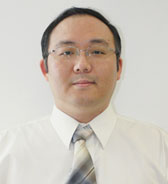|

|
Prof. Da-Wei Zhang (张大为 教授)
Division of Chemistry and Biological Chemistry
Nanyang Technological University, Singapore
Email: dawei53@gmail.com
|
Abstract: In this presentation, I will present the ability of conventional molecular dynamics (MD) simulation to evaluate protein stability upon mutation by conducting simulations in explicit 2 M urea solution for four apomyoglobin (ApoMb) variants namely wildtype (WT), E109A, E109G and G65A/G73A. Based on the simulations conducted, analyses such as variation in root-mean-square deviation (rmsd), native contacts and solvent accessible surface area with time were conducted to compare the stability of the ApoMb variants. Subsequently, the mechanism leading to the destabilization of the ApoMb variants were also studied through the calculation of correlation matrix, principal component analyses, hydrogen bond analyses and root-mean-square fluctuation (rmsf). The effect of mutation on the stability of ApoMb variants to urea unfolding had been conducted experimentally by Baldwin and Luo. The results obtained in this study correlates well with that acquired by Baldwin and Luo whereby E109A mutation was shown to stabilize ApoMb while E109G and G65A/G73A mutation showed otherwise. This positive observation showcases the feasibility of exploiting MD simulation in the determination of protein stability prior to protein synthesis.
About the Speaker: Zhang Dawei obtained his Ph.D. in Theoretical/Computational Chemistry from New York University Chemistry Department under Professor John Z.H. Zhang, developing a new algorithm to calculate the ab initio interaction energy between protein and drug molecule. After graduation in 2005, he worked as postdoctoral fellow and assistant research scientist under Prof. Sylvia Lee-Huang at New York University Langone Medical Center, Department of Biochemistry. His postdoctoral research focused on the discovery of natural anti-HIV and anti-obesity agents. His role is to identify the key components in plant extract using molecular docking simulation and examine their biological activities experimentally to confirm modeling predictions. This work represents a novel new field that merges computational chemistry, structural biology, bioinformatics, viral pathogenesis for rational development and targeted design of smart drugs. He joined NTU in June 2008.
Date&Time: March 5, 2014 (Wednesday),10:30 -11:30 a.m.
Location: 606 Conference Room 

